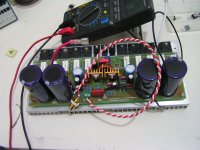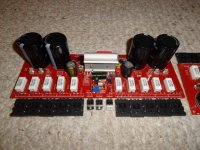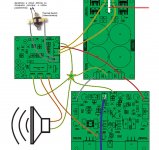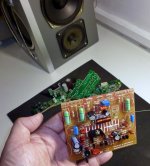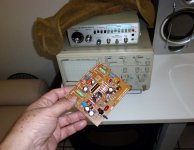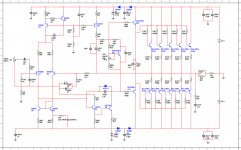I just noticed that the original schematic had R21 as 1k2. The latest version has it changed to 680. Would it hurt to try 1k2 int there instead. As I said, I have my 1k pot maxed out and it is just enough on the one channel and not enough on the other. It would seem that the 1k2 would give me a little breathing room.
What do you guys think?
Thanks Terry
What do you guys think?
Thanks Terry
Mine is 1k and has enough range to adjust the bias with high voltage rails. If you have one channel behaving that much differently than the other then you have a component or wiring difference between the two.I just noticed that the original schematic had R21 as 1k2. The latest version has it changed to 680. Would it hurt to try 1k2 int there instead. As I said, I have my 1k pot maxed out and it is just enough on the one channel and not enough on the other. It would seem that the 1k2 would give me a little breathing room.
What do you guys think?
Thanks Terry
Hi Bonfis,
Yesterday I put a 1k2 in there and am able to adjust the bias at the 75V rails. However I am not too happy with the amount of offset an how dependent it seems to be on the temperature of the VAS transistors. I fashioned some large heatsinks and connected them. They are keeping the temperature down but still I see the offset rise as they warm up. I have the two transistors sharing the heatsink and I am now wondering if that is a mistake. Today I will try attaching separate heatsinks and see how they react to that. I still have about +40mv offset. I know that won't hurt anything but I'd still like to see it a little lower.
Blessings, Terry
Yesterday I put a 1k2 in there and am able to adjust the bias at the 75V rails. However I am not too happy with the amount of offset an how dependent it seems to be on the temperature of the VAS transistors. I fashioned some large heatsinks and connected them. They are keeping the temperature down but still I see the offset rise as they warm up. I have the two transistors sharing the heatsink and I am now wondering if that is a mistake. Today I will try attaching separate heatsinks and see how they react to that. I still have about +40mv offset. I know that won't hurt anything but I'd still like to see it a little lower.
Blessings, Terry
OK, Here's where I am now. I've got both channels mounted on the heatsink and hooked up to the power supply. With speakers hooked and no sound on the input the PS is holding right at +/-74.8VDC. playing loudly it drops to maybe 72.5VDC at very loud passages. Looks like the transformer is ample.
Now for the negatives.
I have a hum when something is connected to both channels. If I connect my Zune to only one channel at a time there is no hum. As soon as I connect the second channel I get a hum. I am using a star ground. Both board grounds are connected to it as well as the ground side of the speaker. Signal grounds go to the ground point at the input. I jumpered the place that called for R30 per Carlos's suggestion. I tried running the input grounds to the star and that is worse. I tried tying both input grounds together and only connecting them to one side and that didn't work either. I also tried feeding the amp with a preamp and the hum is the worst that way. I am open for suggestions.
My other issue is the sound. The highs have too much snap to them. Even at modest volumes there is just too much sizzle on the highs. I hooked up my scope and sinewave generator and ran both a square wave and sine wave through it. You can see the results below. The clipping starts at about 30VAC with an 8ohm dummy load attached.
Thanks, Terry


Now for the negatives.
I have a hum when something is connected to both channels. If I connect my Zune to only one channel at a time there is no hum. As soon as I connect the second channel I get a hum. I am using a star ground. Both board grounds are connected to it as well as the ground side of the speaker. Signal grounds go to the ground point at the input. I jumpered the place that called for R30 per Carlos's suggestion. I tried running the input grounds to the star and that is worse. I tried tying both input grounds together and only connecting them to one side and that didn't work either. I also tried feeding the amp with a preamp and the hum is the worst that way. I am open for suggestions.
My other issue is the sound. The highs have too much snap to them. Even at modest volumes there is just too much sizzle on the highs. I hooked up my scope and sinewave generator and ran both a square wave and sine wave through it. You can see the results below. The clipping starts at about 30VAC with an 8ohm dummy load attached.
Thanks, Terry


These wave shapes are awfull.
Naturally i have never watched that before.
Having hum means you grounding is not good, as you know, and wave shape under this condition naturally will show not normal things.
I am sure people have not faced this before..... give a try to fix the stuff before to publish images this way as some people, not so skilled as you are, may be scared..... poor guys...they gonna be in panic...very ugly wave shape.
Check for mistakes, no Dx amplifier is released this way...naturally.
I am sure you do not want to spread panic dear Terry, of course you just want to know if someone have faced the same trouble...to save you some time searching.. but beginners may wet their pants in the meanwhile.... i hope you find the trouble to post some "heroic" pictures because these ones....my God!
For sure you will find the error, but in the meantime we gonna have people having heart stroke.
regards,
Carlos
Naturally i have never watched that before.
Having hum means you grounding is not good, as you know, and wave shape under this condition naturally will show not normal things.
I am sure people have not faced this before..... give a try to fix the stuff before to publish images this way as some people, not so skilled as you are, may be scared..... poor guys...they gonna be in panic...very ugly wave shape.
Check for mistakes, no Dx amplifier is released this way...naturally.
I am sure you do not want to spread panic dear Terry, of course you just want to know if someone have faced the same trouble...to save you some time searching.. but beginners may wet their pants in the meanwhile.... i hope you find the trouble to post some "heroic" pictures because these ones....my God!
For sure you will find the error, but in the meantime we gonna have people having heart stroke.

regards,
Carlos
Attachments
Last edited:
Sorry, not trying to scare anyone. Just looking for help. I have gone over all the resistors values to make sure I have them correct. They match what the schematic I worked from show. It may have been my choice of caps. I used ceramic for most of the 100nf because I have a bag full of them. I should probably replace those with film and retest. I was hoping someone had had a similar experience and could point me in the right direction. You say you have never seen this. I find that strange since you talk about how many failed amps you have built over the years..
I started investigating a little and I see that I may not have all the parts agreeing. In the last three pages of this thread, there are several schematics claiming to be the "latest". I tried, before I started populating the board, to gather the most recent info adn put together a BOM. However, while looking through the paperwork the I compiled I see that I may have substituted some of the new info without substituting "all" of the new info. I am going to have to stop and go through all of this again and try to decipher what has been deemed the best combination. I'll get back after I have had a chance to do this. I have other amps to work on so I will be getting back to this soon.
Carlos,
I pull down the links to those pictures so no one else gets the idea that building one of these amps might not end in nirvana.
Blessings, Terry
Carlos,
I pull down the links to those pictures so no one else gets the idea that building one of these amps might not end in nirvana.
Blessings, Terry
Oh!..now i remember Cannonica told me something alike
The after death experience......now i remember.
This amplifier alike any other, has an usefull range...the range you should use if from iddle to the threshold of clipping...and within this range it should me measured, listened and evaluated.
After a couple of years i continue not understanding the point to worry about the "after death" experience when the amplifier is playing outside the usefull range...the non noise when switched off and the presence of noises and obvious distortions when we force it to operate into the distortion range....naturally it distorts...and if it distorts yellow or brown i really do not care about and i cannot understand the obsessive feeling this produces in some people.
Imagine you have an engine...it can go from iddle to 6000 RPM, and then you decide to turn it to 7000 RPM will it breaks down....then you say it goes noise when desintegrating?.... i cannot see the point of that.
Or someone that wants to know the real after death experience...then he take poison and force his own death to anwer to himself the after death experience not to be living with the fear of death anymore... a dead having fear of death?... someone that cannot know trying to know...a brain that does not exist anymore ....thinking? ... remembering the death?
When clipping the amplifier shows you simetry or not.... can show you when you enter the range where the sound gets distorted and unless we are not mad, we will not cranck the volume there...we will just listen in some moment of peaks..then the audio gonna be dirty..naturally.
Doctors need some obsessive folks to survive.... now a days i got the point..they would not exist if we do not have people having disorders... without people having strange worries no psycho doctor will make it's living.
Even before the clipping you already can see signs of the frequency response.....it is not something you need to clip an amplifier to measure..also the slew rate can be measured in other levels of power.... so the only worry i can understand if the amplifier will break down, with transistors burning when we clip...this is serious but it is not the case...people worries with waveshape outside the usefull range?....they will be more nervous if they increase the input level....naturally the wave shape will be worst......who knows...some may be measuring how worst this can be.
Audio amplifier are made to play music, not noises....and when you clip you start to have noises... interesting people wanting to know if this noises are from a deep cavern or from the deep ocean.
Superimposed oscilations, audio triggered oscilations, frequency response, the frequency you start to have a triangle waveform when increasing sinusoidal frequency injected to the input....this stuff are fair worries...but what happens after death?
I am sorry...maybe i am too much stupid....i just cannot understand, and i have commented that several years ago when BMW850, Cannonica and one more guy started to worry about "after death experience"...or..operating an amplifier in a different way...forcing it to distort..... i really cannot discuss the stuff.
Maybe someone will try a torch to increase temperature to 150 degrées celsius to see if the amplifier has a noiseless death...or to put it inside the swiming pool.
Once, while in the college, we enter a mad people hospital...and a friend started to discuss with a guy that had the belief he was Napoleon Bonaparte reincarnation....and that friend, one of the worse students we had said that must show the guy the "impact of reality" to bring the guy back to the reality...and he was saying to the men.
- No!.you are not Napoleon!
I am out of this kind of discussion..... about the subject, this is my second post and final about that.
regards,
Carlos
The after death experience......now i remember.
This amplifier alike any other, has an usefull range...the range you should use if from iddle to the threshold of clipping...and within this range it should me measured, listened and evaluated.
After a couple of years i continue not understanding the point to worry about the "after death" experience when the amplifier is playing outside the usefull range...the non noise when switched off and the presence of noises and obvious distortions when we force it to operate into the distortion range....naturally it distorts...and if it distorts yellow or brown i really do not care about and i cannot understand the obsessive feeling this produces in some people.
Imagine you have an engine...it can go from iddle to 6000 RPM, and then you decide to turn it to 7000 RPM will it breaks down....then you say it goes noise when desintegrating?.... i cannot see the point of that.
Or someone that wants to know the real after death experience...then he take poison and force his own death to anwer to himself the after death experience not to be living with the fear of death anymore... a dead having fear of death?... someone that cannot know trying to know...a brain that does not exist anymore ....thinking? ... remembering the death?
When clipping the amplifier shows you simetry or not.... can show you when you enter the range where the sound gets distorted and unless we are not mad, we will not cranck the volume there...we will just listen in some moment of peaks..then the audio gonna be dirty..naturally.
Doctors need some obsessive folks to survive.... now a days i got the point..they would not exist if we do not have people having disorders... without people having strange worries no psycho doctor will make it's living.
Even before the clipping you already can see signs of the frequency response.....it is not something you need to clip an amplifier to measure..also the slew rate can be measured in other levels of power.... so the only worry i can understand if the amplifier will break down, with transistors burning when we clip...this is serious but it is not the case...people worries with waveshape outside the usefull range?....they will be more nervous if they increase the input level....naturally the wave shape will be worst......who knows...some may be measuring how worst this can be.
Audio amplifier are made to play music, not noises....and when you clip you start to have noises... interesting people wanting to know if this noises are from a deep cavern or from the deep ocean.
Superimposed oscilations, audio triggered oscilations, frequency response, the frequency you start to have a triangle waveform when increasing sinusoidal frequency injected to the input....this stuff are fair worries...but what happens after death?
I am sorry...maybe i am too much stupid....i just cannot understand, and i have commented that several years ago when BMW850, Cannonica and one more guy started to worry about "after death experience"...or..operating an amplifier in a different way...forcing it to distort..... i really cannot discuss the stuff.
Maybe someone will try a torch to increase temperature to 150 degrées celsius to see if the amplifier has a noiseless death...or to put it inside the swiming pool.
Once, while in the college, we enter a mad people hospital...and a friend started to discuss with a guy that had the belief he was Napoleon Bonaparte reincarnation....and that friend, one of the worse students we had said that must show the guy the "impact of reality" to bring the guy back to the reality...and he was saying to the men.
- No!.you are not Napoleon!
I am out of this kind of discussion..... about the subject, this is my second post and final about that.
regards,
Carlos
Last edited:
My dear old friend Terry.... this is Terryific and a
Terryfying experience my dear.
As soon as you fix the ground loop issues (use star ground or disconnect it if already using) post some better waveforms.
All that stuff is Terryble to beginners...for them the amplifier is a piece of.... when it is not.
I could not post my experience several years ago...the one had not anwer... it do think he is not, anymore, in this forum..maybe not a diyer anymore..maybe migrate to other hobby.
"A couple years ago, one guy that assembled a Dx amplifier, the standard one, said after he switched the power of..while supply capacitors discharging, then the amplifier farted...made a noise alike gases being spelled...he asked me if this was natural, or normal....he had no answer...i keep my silent not to say the amplifier made the noise in honor of his intelligence."
Poor beginners....people that bougth pcboard and will build his first high power audio amplifier..and then he comes to see instructions and find a skilled senior electronic man, alike Terry, saying.
What is this?
I am sure you are only searching for answers to save time dear Terry...there's no problems about that..we are in a forum..the place to do it..but sometimes, old guys alike us, we are REFERENCE..and young folks hope we know what we are doing..when we see we have doubts..they become scared.
Terryfying and this stuff is because i like you...just kidding..no bad feelings..the opposite, you are humble enougth to say you feel confused....and this is something i strongly appreciate dear Terry.
Watch up to the future...you are reference.
regards,
Carlos
Terryfying experience my dear.
As soon as you fix the ground loop issues (use star ground or disconnect it if already using) post some better waveforms.
All that stuff is Terryble to beginners...for them the amplifier is a piece of.... when it is not.
I could not post my experience several years ago...the one had not anwer... it do think he is not, anymore, in this forum..maybe not a diyer anymore..maybe migrate to other hobby.
"A couple years ago, one guy that assembled a Dx amplifier, the standard one, said after he switched the power of..while supply capacitors discharging, then the amplifier farted...made a noise alike gases being spelled...he asked me if this was natural, or normal....he had no answer...i keep my silent not to say the amplifier made the noise in honor of his intelligence."
Poor beginners....people that bougth pcboard and will build his first high power audio amplifier..and then he comes to see instructions and find a skilled senior electronic man, alike Terry, saying.
What is this?
I am sure you are only searching for answers to save time dear Terry...there's no problems about that..we are in a forum..the place to do it..but sometimes, old guys alike us, we are REFERENCE..and young folks hope we know what we are doing..when we see we have doubts..they become scared.
Terryfying and this stuff is because i like you...just kidding..no bad feelings..the opposite, you are humble enougth to say you feel confused....and this is something i strongly appreciate dear Terry.
Watch up to the future...you are reference.
regards,
Carlos
Attachments
Last edited:
Now i am an old guy...but i can remember...and very well
down the sixties...the passion by transistors...the first transistorized radio.... the love started there.
How i had respect with these magical things...i had no knowledge..and sometimes when radio fails i use to clean with soap (ahahahaha)...or to melt the paraphine or wax they used into coils.
I had doubts about how long should be a transistor lead..and if the length was equal or not....so scared i was.
Because of that i know very well how beginners feel....i am one of them.... 54 years ago...i was one of them..but as my memory of feeling survive...i can say i am one of them.
So important gray hairs guys.... they are the ones guide us into the mined field..these guys can not tremble, nor fear, nor falter, nor have questions or panic will settle,
I was searching the grounding layout....maybe you can find it in the old MKIII builder's thread.
This amplifier had several group buys... three in foreign countries, in international forums (diysmps and diyaudio) and two in Brazil.... aprox. 280 guys have these pcboards...now a days Zimmer has some samples left inside his drawer.... protected by plastic air bubble envelope.
Hugh Dean told me once.
- Relax Carlos.... enjoy your life...we have more 10 years left.
Now 7 years dear Hugh!
regards,
Carlos
down the sixties...the passion by transistors...the first transistorized radio.... the love started there.
How i had respect with these magical things...i had no knowledge..and sometimes when radio fails i use to clean with soap (ahahahaha)...or to melt the paraphine or wax they used into coils.
I had doubts about how long should be a transistor lead..and if the length was equal or not....so scared i was.
Because of that i know very well how beginners feel....i am one of them.... 54 years ago...i was one of them..but as my memory of feeling survive...i can say i am one of them.
So important gray hairs guys.... they are the ones guide us into the mined field..these guys can not tremble, nor fear, nor falter, nor have questions or panic will settle,
I was searching the grounding layout....maybe you can find it in the old MKIII builder's thread.
This amplifier had several group buys... three in foreign countries, in international forums (diysmps and diyaudio) and two in Brazil.... aprox. 280 guys have these pcboards...now a days Zimmer has some samples left inside his drawer.... protected by plastic air bubble envelope.
Hugh Dean told me once.
- Relax Carlos.... enjoy your life...we have more 10 years left.
Now 7 years dear Hugh!
regards,
Carlos
Attachments
This amplifier was created into my workbench
And was tuned there..then i have entered with the schematic into Multisim 12 to check it.
My scope was damaged.... i felt the sound excellent and i had the belief waveform was perfect..also simulator was confirming this to me...all analises fine.... the most important ones... AC analisis and Fourier analisis.
Then i have asked a friend..not that skilled, to test it using his scope and his generator and i gave him instructions...but all them to adjust below the threshold of clipping.
I really have not watched in the real world, myself, into a scope...i have assembled mine and listened (now partially dismounted) and really i have not watched the clipping behavior.... the onset of clipping.
I am really busy to assemble again to check once more the waveforms.... so...i suggest you to go back to informations posted by BMW850 and Cannonica..the ones i remember said something about.
regards,
Carlos
And was tuned there..then i have entered with the schematic into Multisim 12 to check it.
My scope was damaged.... i felt the sound excellent and i had the belief waveform was perfect..also simulator was confirming this to me...all analises fine.... the most important ones... AC analisis and Fourier analisis.
Then i have asked a friend..not that skilled, to test it using his scope and his generator and i gave him instructions...but all them to adjust below the threshold of clipping.
I really have not watched in the real world, myself, into a scope...i have assembled mine and listened (now partially dismounted) and really i have not watched the clipping behavior.... the onset of clipping.
I am really busy to assemble again to check once more the waveforms.... so...i suggest you to go back to informations posted by BMW850 and Cannonica..the ones i remember said something about.
regards,
Carlos
Attachments
Last edited:
Here you have the videos i told you
Thank you by the attention...all my concerns are in these videos.
Observing the MKIII once again - YouTube
My concern about the MKIII - YouTube
regards,
Carlos
Thank you by the attention...all my concerns are in these videos.
Observing the MKIII once again - YouTube
My concern about the MKIII - YouTube
regards,
Carlos
I can say I'm not an expert but I did build MKIII and it was an exceptional
experience for me building a high power amplifier for the first time in my life
and I use
all my knowledge that I learn in the Army as 94F "Special Electronic Device
Repair Specialist"
to build it, I check every single resistors I check 1,2,3,4,5,6 times that
I have the correct transistors the TO-92 all traces all pads, what I'm trying to say
is that this can be done smoothly, after all is done guys believe me is worthy at
the end music will come out nice and enjoyable I'm telling you it does make a
difference in sound just be patience on the build step by step guys
Regards
Juan
experience for me building a high power amplifier for the first time in my life
and I use
all my knowledge that I learn in the Army as 94F "Special Electronic Device
Repair Specialist"
to build it, I check every single resistors I check 1,2,3,4,5,6 times that
I have the correct transistors the TO-92 all traces all pads, what I'm trying to say
is that this can be done smoothly, after all is done guys believe me is worthy at
the end music will come out nice and enjoyable I'm telling you it does make a
difference in sound just be patience on the build step by step guys
Regards
Juan
Thank you Juan....i have strong concerns about how a beginner will feel
Watching these waveforms....they are a hell ugly and abnormal....they may think the amplifier is broken or something alike.
A fairy tale..just an history i have created into my personnal analisis of the subject i am facing:
I was thinking about an exotic doctor inside a hospital..then someone was sick, a serious disease..and then the doctor said:
- This disease can kill this man...he is in the threshold of death..... you can see that he is not strong enougth to survive if you submit it to some stress.
Then he ordered to reduce the ventilation frequency, and amplitude...the air quantity and the medicine to control heart beats, blood pressure and so on... also some blood sugar containts ....then the sick man died.....and the doctor said.
- You see i am right!..... he died....so..... what he was showing (clipping distortions) was a signal he was in the death threshold!
Above is just an example.... a fiction...playing only...as some guys will say we must overdrive to understand what is going on when the amplifier is overdrive...some apocalypse theorists.
So...we must kill to prove the guy can die...or submit it to stress to prove he was in the threshold to go to heaven..... or hell....who knows.
If someone intend o kill an amplifier submiting it to suffering, going to clipping and letting it play square waves for long time...well....better to take a sledge hammer and smash it....more efficient killing will be done this way
When people overdrive, then transistors goes to saturation, and square wave is produced because overdrive, not the amplifications of a square wave within the limits of operation (rail to rail) of this same amplifier.... when we do that we start to conduct full current from the supply in a switching mode....not only that but this produces a lot of harmonics... and you see people doing that...things they do not do when they test their own amplifier...then they inject audio, in square wave, to 1 watt, or 10 watts to a 100 watts power amplifier..also do not inject 20 kilohertz....they inject 10 kilohertz...hehehehehehe.... with their amplifier, their design, then they are tollerant...but with amplifiers from others they want to see the behavior with impossible loads..they will ask you to install 1 ohm...or to make short.....so nice they are!
regards,
Carlos
Watching these waveforms....they are a hell ugly and abnormal....they may think the amplifier is broken or something alike.
A fairy tale..just an history i have created into my personnal analisis of the subject i am facing:
I was thinking about an exotic doctor inside a hospital..then someone was sick, a serious disease..and then the doctor said:
- This disease can kill this man...he is in the threshold of death..... you can see that he is not strong enougth to survive if you submit it to some stress.
Then he ordered to reduce the ventilation frequency, and amplitude...the air quantity and the medicine to control heart beats, blood pressure and so on... also some blood sugar containts ....then the sick man died.....and the doctor said.
- You see i am right!..... he died....so..... what he was showing (clipping distortions) was a signal he was in the death threshold!
Above is just an example.... a fiction...playing only...as some guys will say we must overdrive to understand what is going on when the amplifier is overdrive...some apocalypse theorists.
So...we must kill to prove the guy can die...or submit it to stress to prove he was in the threshold to go to heaven..... or hell....who knows.
If someone intend o kill an amplifier submiting it to suffering, going to clipping and letting it play square waves for long time...well....better to take a sledge hammer and smash it....more efficient killing will be done this way

When people overdrive, then transistors goes to saturation, and square wave is produced because overdrive, not the amplifications of a square wave within the limits of operation (rail to rail) of this same amplifier.... when we do that we start to conduct full current from the supply in a switching mode....not only that but this produces a lot of harmonics... and you see people doing that...things they do not do when they test their own amplifier...then they inject audio, in square wave, to 1 watt, or 10 watts to a 100 watts power amplifier..also do not inject 20 kilohertz....they inject 10 kilohertz...hehehehehehe.... with their amplifier, their design, then they are tollerant...but with amplifiers from others they want to see the behavior with impossible loads..they will ask you to install 1 ohm...or to make short.....so nice they are!
regards,
Carlos
This thread is still alive ?!? 
Terry, see an image of my actual components. This is what's actually playing. I don't have an updated BOM since I did some part swaps without updating my initial BOM.
The things that may be particular in my case are my choice of CCS and VAS transistors, Cdom at 100pF, clamping diode over it, drivers base resistors at 100R, the gain-controlling R9 @ 1.5K, the 10nF in parallel with C9, and my BIAS now set to 24mV across both emitter resistors.
Martin.
Terry, see an image of my actual components. This is what's actually playing. I don't have an updated BOM since I did some part swaps without updating my initial BOM.
The things that may be particular in my case are my choice of CCS and VAS transistors, Cdom at 100pF, clamping diode over it, drivers base resistors at 100R, the gain-controlling R9 @ 1.5K, the 10nF in parallel with C9, and my BIAS now set to 24mV across both emitter resistors.
Martin.
Attachments
Let me give a little history about myself. I was born in 1952. Became a musician in 1962. Back in the 60's and 70's, in my circle of friends, having a nice stereo system was more prestigious than having a nice car. I always wanted one but couldn't afford it. Life took over and job and family became center of attention. Well now many years later, I was given some JBL speakers that needed to be repaired and through getting help with that I discovered DIY audio. So now, I can maybe have that awesome stereo system I had always longed for. So with the help of some very knowledgeable folks here I was able to build my first amp, The ESP P101. I was hooked. Next came the Leach Superamp. Oops, didn't work. Tried and tried but could get it to work. No matter, I set it aside and built a Krell KSA 50. Success. Then another KSA50 with plastic outputs. Success. Then the Leach Low TIM, Symasym, 5.0, Symasym 5.3 & Aleph-X. Because I have no electronic background, I had to ask for help with each of these amplifiers. With each one, I learned a little more. I stopped doing this in 2008 and just started again a couple months ago. My goal was to make use of most of the components that I had stockpiled during my previous experience. This included a few transformers. So I have this 55-0-55Vac transformer that I need an amp for. I read about this MKIII with it's 5 pair of outouts and think it will make good use of my transformers. Now I see that it was not really designed for that much voltage. Guys have done it, but with special considerations. They have enough electronic knowledge to be able to tweak it to work. I don't so I need help. I tried reading back through the thread to find the best combination to make this work but there are so many different schematics posted in this thread that it is just too confusing. I have very limited experience reading a scope. I mainly use it to warn me if there is something dangerous happening before I hook up any speakers. If it looks OK then I go ahead and hook up my test speakers. Then when something doesn't sound right to me I will post a picture of what I see on the scope so guys who have more experience than me might be able to help me gt it working properly. Normally they are not the ones who designed it so they are open minded about helping. I see that you have taken offense that I am insulting the design when I am only saying that I have done something wrong and am just looking for help in finding it. There is really no need for you to defend your design. I am convinced that built properly, it is very good. I didn't do that. I will not post any more until I have found the problem.
Blessings, Terry
Blessings, Terry
- Status
- Not open for further replies.
- Home
- Amplifiers
- Solid State
- Dx Blame MKIII-Hx - Builder's thread
